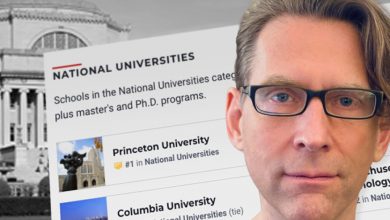More Students Want Virtual-Learning Options. Here’s Where the Debate Stands.

[ad_1]
Concentrating in large lecture halls has always been a challenge for Harper Chambers, a rising senior studying neuroscience at Princeton University. That’s because Chambers has autism, which he said makes him extra sensitive to light and noise. But when Chambers got a concussion last fall, his “acute” sensitivity temporarily became even more severe.
Side conversations and the clicking of keyboards drowned out his professor’s lecture and soon became indistinguishable white noise. Lights from peers’ laptop screens and overhead lamps were distracting and gave him a headache. Sunglasses and noise-canceling headphones didn’t help much.
“I couldn’t be in the room and be able to fully focus on the lecture,” Chambers said.
He went to the university’s disability office to ask for permission to attend class on Zoom — a policy he remembered from the year before, when Covid exposures and infections would often force students into quarantine or isolation.
Then Chambers learned that Princeton no longer required faculty to provide Zoom accommodations for any reason.
After the 2021-22 academic year, when faculty across the country reported “stunning” levels of student disengagement, Princeton and other colleges with a lot of residential undergraduates sought to reestablish the norms and atmosphere of college from before the pandemic. At the University of Oregon, a senior administrator was direct in an email to the campus: “Students need to hear that attendance is important to their learning.”
For some faculty, the need to accommodate students — some of whom kept attending their mostly in-person classes online, Covid or no Covid — was ballooning their workloads. Instructors had to figure out how to record lectures, measure participation, and facilitate small-group activities simultaneously in-person and online. And instructors feared that academic rigor was suffering.
This eagerness to return to “normal” coincided with a growing demand from many students for virtual learning.
While adult learners have long preferred such flexibility, students and others told The Chronicle that more 18- to 24-year-olds also want online courses — as well as hybrid courses, where they can attend a class in-person one day and virtually the next. Some, like Chambers, are disabled students; others are students with jobs or caretaking responsibilities.
The share of students enrolled only in online courses nearly doubled between 2019 and 2021, according to a recent analysis by The Chronicle. Some college officials told The Chronicle this spring that they are continuing to expand remote and hybrid options.
It’s clear that the conversation about flexibility in learning, and how to help faculty offer it, will persist even as the pandemic era recedes into the distance.
‘The World Opening Up’
Last fall, Princeton officially ended hybrid learning and began requiring all students to attend all classes in person. (The university doesn’t offer fully online degree programs.)
“Those who miss more than two weeks of instruction — for any reason — are encouraged to take a leave of absence,” Jill S. Dolan, dean of the college at Princeton, wrote in a September 2022 essay. Asked for further comment, a Princeton spokesperson referred The Chronicle to the essay.
Disability-rights student groups had urged Princeton to preserve Covid-era accommodations. But Dolan said those adaptations just weren’t working for students or faculty.
Learning happens best during “present-time interactions with faculty and other students,” Dolan said, where students have “the chance to see, in real time, our collective minds transform.”
“Virtual learning makes taking a meaningful stand more difficult, because we’re not breathing the same air and we can’t see the nuances of one another’s expressions and reactions as we can when we’re present, live, together,” Dolan wrote.
Hybrid teaching in particular was a burden for Princeton’s faculty, who reported “stress and disruption,” Dolan said. In addition to creating “technical and administrative burdens,” simultaneously teaching two audiences — the in-person students and those online — was difficult for some lecturers, she said.
Some instructors reported learning loss among their students, while others noted constant requests for Zoom attendance for different reasons, as well as growing disengagement in class.
“In other words, once that Zoom window opened, faculty found their courses suddenly defenestrated,” Dolan wrote.
For Ellen Li, though, virtual learning was an opportunity to actually participate in class.
“I think it’s important to recognize that for a lot of people, quarantine was the daily state of our lives, and then having everything transitioned to Zoom was actually the world opening up and not closing down,” said Li, a comparative literature student and a co-founder of Princeton’s Disability Collective.
Li started to struggle with chronic illness during her second year at Princeton. Her chronic-fatigue syndrome and dysautonomia affected her mobility, energy, and ability to sit upright in the classroom. In in-person classes, “taking a meaningful stand,” as Dolan described, became difficult for Li.
During the fall of 2019, Li’s illnesses caused her to miss about a quarter of required lectures, she said. When Princeton went online the following spring due to the pandemic, she said she finally felt like she could “meaningfully engage” with peers again. Remote options had been part of the reason she remained enrolled at Princeton after getting sick, she said.
For some disabled students, remote learning “opens up learning possibilities that simply did not exist before, or were very, very burdensome on the student,” said Paul Grossman, a former board member at the Association on Higher Education and Disability, or Ahead, and an adjunct professor of disability law at the University of California College of the Law, San Francisco.
I think it’s great to open up options so that people can make their own individual choices about what works well for them.
Jamie Axelrod, the former president of Ahead and the director of disability resources at Northern Arizona University, said that it is “hard to make generalizations” about which student populations benefit from online learning. While some disabled students thrive in a remote environment, others — such as those with attention-deficit or executive-functioning issues — struggle, Axelrod said.
Still, for students who find it complicated to get to and spend time in public settings, remote learning can be a big help, Axelrod said. That group includes students with chronic illnesses, mobility issues, gastrointestinal issues, and certain mental-health conditions.
“I think it’s great to open up options so that people can make their own individual choices about what works well for them,” Axelrod said.
Li, who helped advocate for the university to preserve remote options last spring with Princeton’s disability collective, said she understands why many of her classmates prefer in-person learning. For some disabled students, though, Li said the options are “online or nothing.”
“Providing no online option is equivalent to denying disabled students, and teachers, any place in the university,” Li said.
Meeting Demand
While some colleges aim to put Zoom classes in the past, others are taking advantage of the rising demand among students for remote and hybrid learning — in part as an enrollment strategy.
Vermont State University, the soon-to-be-formed institution unifying three public colleges that were losing students, is making a bet on flexibility. Sylvia Plumb, a spokesperson, wrote in an email that “remote/hybrid learning plays a vital role in our mission to provide high-quality, accessible education that is affordable and tailored to the needs of our diverse student population.”
At the University of Maine at Orono, the share of remote-course offerings doubled between 2019 and this spring, from 14 to 28 percent, officials said. The share of students learning fully online increased 14 percentage points, to 20 percent, between 2017 and 2021, according to The Chronicle‘s recent analysis.
Richard Roberts, executive director of academic-program support and online learning at Maine, said the decision to expand was based on demand from students who inceasingly want a combination of in-person, hybrid, and fully remote courses.
“When we offer remote versions of our on-campus courses, or fully online versions of our existing degrees, they often reach capacity well before the on-campus sections,” Roberts said.
Roberts said the university has been able to expand remote options “without sacrificing academic rigor or credential value.”
“We have a robust infrastructure to support fully remote students and in-person students seeking a variety of hybrid and remote options,” Roberts said. “Most importantly, our online degrees and courses are not separate from the on-campus offerings, and so our fully remote students take the same classes, learn from the same prestigious research-intensive faculty, and earn the same degrees as our on-campus students.”
Roberts said Maine also has a dedicated advising team for supporting online students so they feel less “like a number.”
He said the university is committed to meeting the needs of the state. “Maine is a predominantly rural state, and many students are geographically place-bound, yet they still deserve the option to earn a quality education,” Roberts said.
You’re able to take your classes and not have to worry about that commute, and therefore having to fill up your tank.
Remote options don’t only benefit students with disabilities, some learning experts said. They also expand access for commuter students, students with jobs, and students who care for family members, said Antija M. Allen, an assistant professor of psychology at Pellissippi State Community College, in Tennessee. Allen, an expert in education technology, also serves as director of the Pellissippi Academic Center for Excellence.
“We’ve seen quite a few prices go up, including gas prices,” Allen said, referring to the barriers for commuters who live far away. Remote classes offer an affordable and time-saving way to continue learning, she said: “You’re able to take your classes and not have to worry about that commute, and therefore having to fill up your tank.”
Jasmine Whaley, a 20-year-old sophomore at Ozark Technical Community College, in Missouri, lives an hour away from her college by car and works full-time at a restaurant near her home.
Whaley, who’s studying biological science, said she strongly prefers remote classes because they save her gas money and time, and allow her to learn at times that are convenient, when she isn’t working. Whaley responded to a Chronicle callout this spring for students who opt for remote learning.
Whaley, who has anxiety, said she also prefers remote classes for her mental health; her “grades are always better online.” In person, Whaley said, “I can’t even concentrate because I’m anxious the whole entire class period.”
A Balancing Act
Going forward, learning experts said, colleges must understand that teaching effectively in online and hybrid environments takes resources: training, technology, and help from teaching assistants, among other things.
Managing in-person classes with some students on Zoom is what faculty most often cite as a burden. In those settings, colleges and instructors have to grapple with when — and for whom — online-learning options are necessary, said Grossman, the disability-law expert.
There are students with suppressed immunity or mobility issues who might prefer to Zoom in to their class for a week if they’ve had a chronic illness flare up. And then there are able-bodied students who might want to sleep in and tune in to the lecture when they want. Drawing distinctions between required accommodations and convenience isn’t easy.
Allen, who leads faculty development at Pellissippi State, has heard from faculty members who want to accommodate students’ remote requests for in-person courses but are unsure how to properly do so.
“Some people struggle with engaging the people on Zoom at the same time as engaging the people who are sitting here in the room,” Allen said. “Again, that’s a skill that has to be developed.”
Online teaching can be just as productive as in-person instruction when done well, said Karen Costa, a faculty-development consultant and online teaching expert.
“In an on-site class, we often only hear from the most-confident extroverted learners,” said Costa, who’s an adjunct faculty member at Southern New Hampshire University and the University of Maryland Global Campus, and has been teaching online for over a decade. But in remote classes, she said she can hear from all of her students.
Additionally, Costa said the chat function on platforms like Zoom provides an opportunity for extroverts to participate in the lesson without causing disruptions. “We can have students sharing resources as we’re teaching in a way that would be kind of disruptive and chaotic in an on-site class,” she said.
When teaching online, Costa said, it is important for faculty to actively reach out to students and create opportunities for them to engage with the course content and with one another.
But instructors need support to do that, she said. College leaders, she said, need to answer to “how they are supporting their faculty not only in developing their online pedagogy, but also in these questions of burnout, trauma, and stress.”
[ad_2]
Source link






